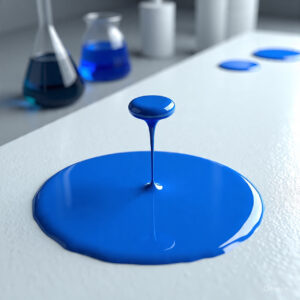Color, Heal, Repeat: The Next Generation of Intelligent Coatings
Seeing a crack or damage on the wall that heals itself without any human intervention feels like magic, right? Here comes the technology where our dream meets reality. Let’s break down the technology to understand its meanings and explore how Thermochromic and self-healing coatings work together after combining.

What are Thermochromic coatings?
Thermochromic coatings change color in response to temperature. The phenomenon is driven by liquid crystal, which is used for precise, reversible color shifts, and Leuco dyes, which are commonly used for larger temperature ranges and have longer durability. These compounds undergo structural changes at specific temperatures, which alter their interaction with visible light, causing a visible color change.
How Does It Work On a Scientific Basis?
- Leuco Dye Systems: It uses a Dye, which is a developer, and a solvent. At high temperatures, the dye molecule becomes transparent, and upon cooling, it reverts to its colored state
- Liquid Crystals: It is align differently depending on the temperature, changing how they reflect the light. It is often used for narrow-range temperature applications.
Key Use Cases:
- Automotive: Temperature-sensitive coatings for dashboards, paint, or tire pressure indicators.
- Smart Packaging: It is used for visual indicators for food freshness or Pharmaceutical safety
- Textiles: Used for Thermochromic fabric for fashion or military camouflage.
- Consumer Electronics: It is used for heat-sensitive coating for safety and aesthetic indicators.
What are Self-Healing coatings?
Self-healing coatings are those that can repair minor damage autonomously without any human intervention and restore their protection and appearance.
Scientific Mechanism Behind Self-healing Coating:
- When damage happens, capsules rupture and release contents, Microencapsulation, which is a healing agents to heal the scratch or crack.
- Intrinsic healing polymers utilize reversible covalent or hydrogen bonding in which heat or UV light trigger self repair
- Supramolecular Polymers based on dynamic has non-covalent interactions which require low activation energy for self repair which is ideal for self repetitive healing.
Key Use Cases:
- Automotive – A scratch-resistant coatings for paint or structural composites.
- Electronics – Has Protective layers for flexible displays and circuit boards
- Construction – It is the coating that heal microcracks in concrete or glass facades.
- Industrial machinery – Protective coatings to extend service intervals.
Combining Thermochromic and Self-Healing Coatings:
Some advanced product have combined both the technologies Multifunctional coating that indicate overheating and self-repair thermal damage and Smart Packaging or Textiles with color coded self healing alerts.
However, even with such great technology there are some Industrial challenges as:
- Technical challenges – Hard to stabilize under such harsh environmental conditions and balancing healing speed vs the durability.
- Cost Implications – Higher upfront R&D and material costs. However, ROI is favorable due to reduced lifecycle maintenance and enhanced functionality
- Scalability – Innovations in nanomaterials and green chemistry are improving scalability for mass production
Beauty meeting technology! Hence we won. When we see innovations like this feel like dream comes true seeing paint industry growing at such a rapid speed and such new innovations are unbeatable. For more such updates and latest news visit Industrial Front.
